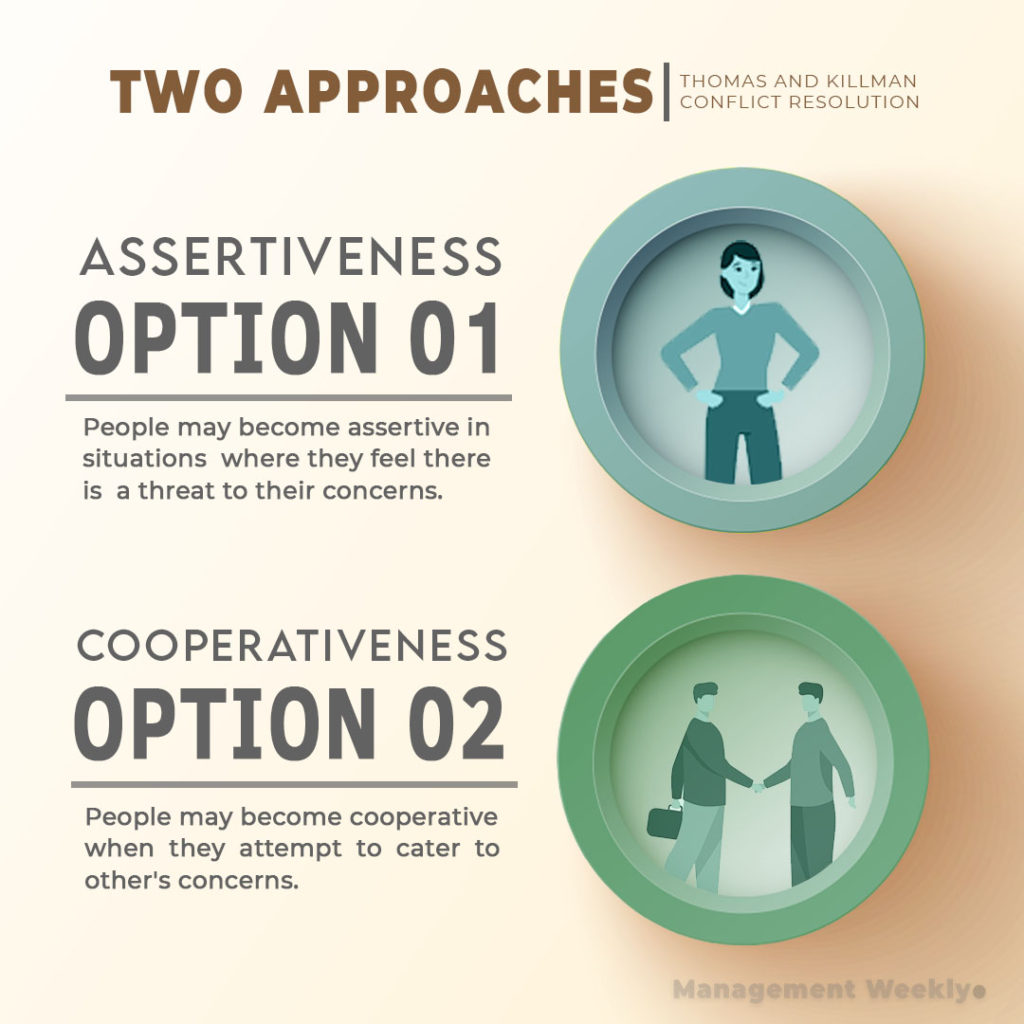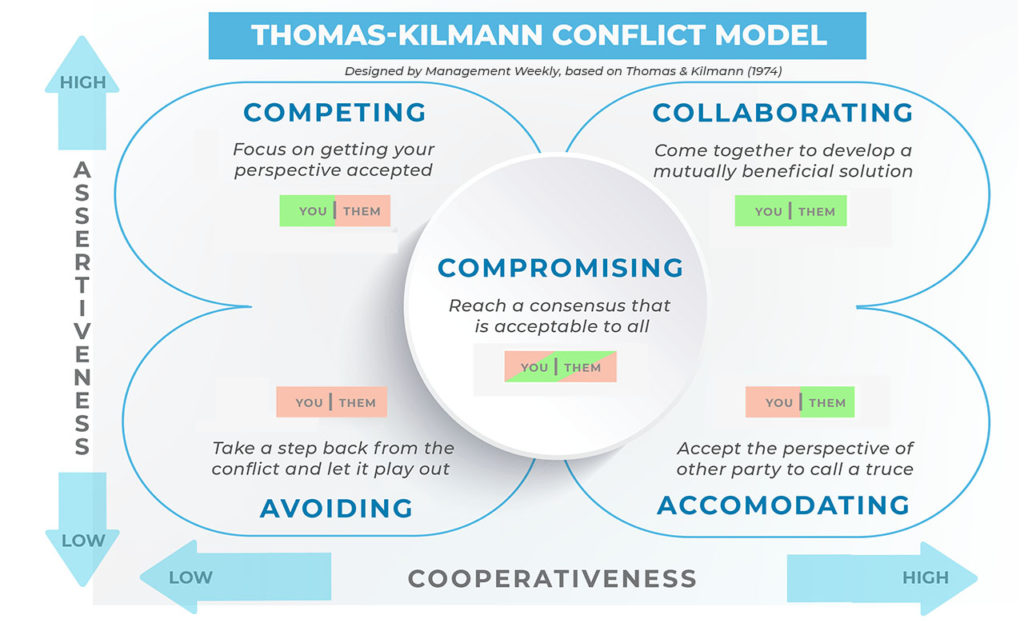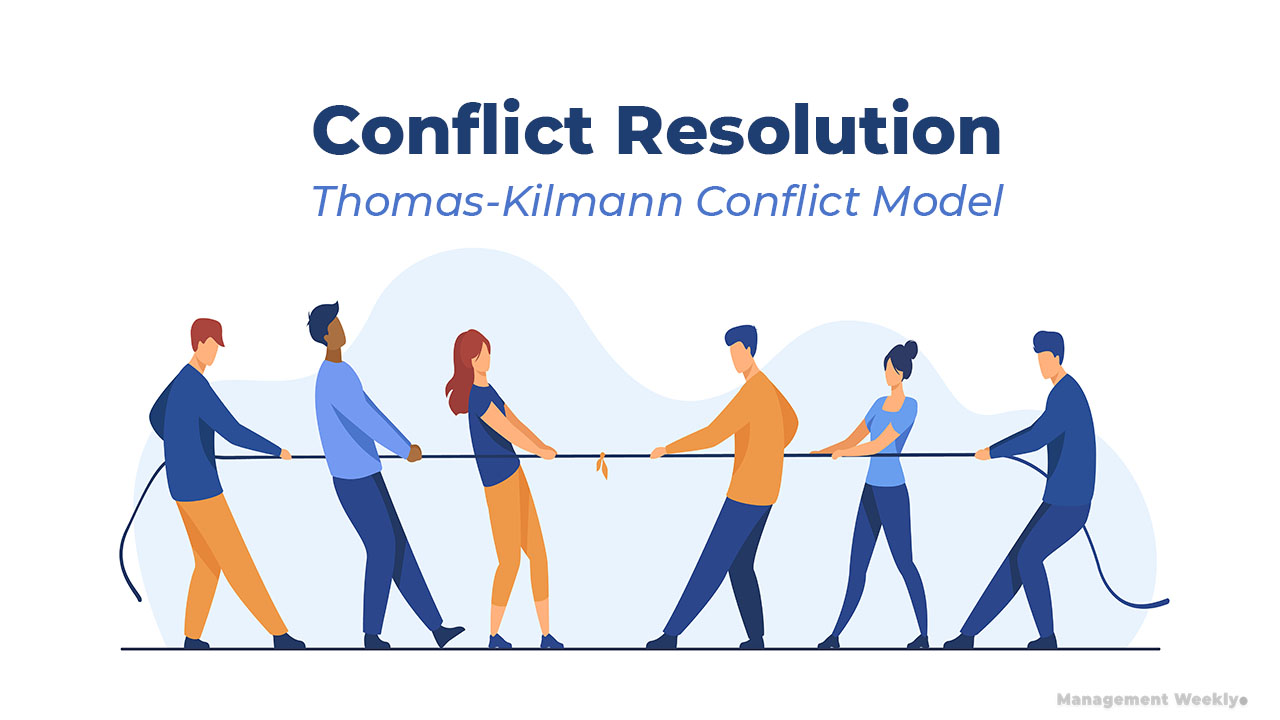It is common for employees to have conflicts with their co-workers. There may be conflicts due to individual differences between co-workers. In addition, there could be task-related conflicts arising from leadership or company policies. In any case, resolving conflicts in the workplace is important. Workplace conflicts are not desirable both for company performance as well as individual well-being. Let us look at Thomas Kilmann Conflict Model to resolve conflicts in the workplace.
Let us consider an example to understand the process of conflict resolution in the workplace. Company ABC has been merged with company XYZ. The top management team of ABC wants to print posters containing the name and picture of their Founder and CEO and have them put up in all departments across both organizations. Company XYZ sees this as an intrusion and also considers it as a wastage of resources. However, ABC, being the more reputed and revenue-generating of the two firms thinks and insists that this move is required to boost the morale of both the firms.
Contents
The Thomas Kilmann Conflict Model
Thomas and Kilmann’s Conflict Model is a powerful way of looking at conflict management. Conflicts are painful for individuals, and it is an important test of managerial skills. Different people respond differently to conflicts. Thomas and Kilmann studied how people managed conflicts. They were greatly inspired by the daily lives of individuals. They observed that most people use one of the five approaches to resolving interpersonal conflicts. Kenneth Thomas and Ralph Kilmann developed a framework using these five approaches. They came up with the Thomas-Kilmann Conflict Mode Instrument or TKI in 1974.
However, let us first understand the nuts and bolts of TKI. Firstly, TKI talks about the two dimensions of conflict management. Think of them as two approaches that you can take. You could be assertive in resolving the conflict or try to be cooperative.
Two Differering Approaches
The Thomas Kilman Conflict Model posits that there are two ‘dimensions’ or approaches for conflict behavior. These approaches are essentially ways of dealing with the situation of conflict. The individuals may choose to be either assertive in their approach or cooperative.

People may become assertive in situations where they feel there is a threat to their concerns. On the other hand, they may become cooperative when they attempt to cater to other’s concerns. These dimensions provide us with a perspective to understand the five modes for managing conflict. Finally, it should be noted that T&K has emphasized that no one approach is superior. A manager should use an approach as per the situation. I have attempted to provide a summary of the two approaches below for easier perusal:
| Assertiveness | Cooperation | |
|---|---|---|
| Best use case scenario | When you need faster decision making. | When both your and conficting party's perspective may be right. |
| When it is ethical and morally right to take a stance. | When your opposing views are better than your. Swallow the pride and take a call for the greater good. | |
| Your views are at loggerheads with others but you are know you are right | You know that the conflicting party is understanding and come to terms easily with a discussion. | |
| As a failback to amicable meands of conflict management. | Long term relationship management. You don't want to win small fights and lose the support of people. | |
| Works best when you have higher power of authority. | Works in all cases. However, depending on the opposing party, cooperative move may appear as weak as well. | |
| Advantages | More powerful approach to make 'your point.' | Amicable means of conflict resolution. Potentiall least amount of damage if it works. |
| Faster decision making, faster resolution of conflict. | Reduces backlash and future problems. | |
| Disadvantages | May lead to retaliation, backlash or damage to relationship. | May not work on people who are adamant or stubborn. |
| In a high power authority culture it may feed the cycle of power hoarding and authority. | May take longer to resolve. |
The Five Modes for Conflict Management
The five modes for conflict management are the core takeaway from Thomas Kilmann’s conflict model. These modes are spread across the two dimensions or approaches as we have discussed earlier. Let us first place them in a chart. This will help us make a better sense of the model. Further, we shall take a deeper dive into each one of these modes.

Competing
At the top left end of the chart, we have high assertiveness and low cooperation. We find competing right at this spot. This means that we use ‘competing’ as a conflict resolution strategy when we resort to being assertive. Additionally, we also become uncooperative with the opposing party. However, this strategy is not as evil as it sounds. This mode may be more appropriate when we need speedy resolution and we are a higher position of power. It is also imperative to use this mode when we have to take tough calls.
Avoiding
The avoiding mode reflects passivity in conflict management. Although, from an ideal perspective, we would agree that we should face the problems, head on. However, the most confident of us would have been in situations where confrontation was best avoided. Also, some problems are so trivial, they are not worth your time.
This approach involves shunning the conflict and withholding one’s views and opinions. People also employ this approach when the cost of confrontation and resolution is far more than the cost of living with the conflict. However, avoiding does not resolve the conflict. On the downside, it just buries it below the surface and may potentially lead to future conflicts.
Accommodating
Now, we are gradually moving towards more amicable means of resolving conflicts. Perhaps, accomodating mode is so considerate of the opposing party that you are ready to call it a truce at the cost of giving up your position. It may be worthwhile in situations when the conflict is a total waste of your time.
The Thomas and Kilmann Conflict Model positions this mode as high in cooperativenes and low in assertiveness. We sacrifice our own stance to make the other party happy.
Collaborating
We use collaborating mode of conflict resolution when we are on the same page as the opposing party. This is an ideal solution. It happens when both parties are sensible, have similar power authority, and are ready to be cooperative with each other. This is easier in a decentralized organization structure.
Typically, the first step is a detailed discussion. We need to understand each other’s viewpoints. This leads to a deeper analysis of the situation. We also try to understand the expectations of each other. Finally, we reach a solution where both parties may benefit.
Compromising
Finally, we arrive at the literal middle ground in the Thomas Kilmann Conflict Model. The center of the chart shows us a point where we are moderately assertive and moderately cooperative. In certain situations, we may not want to have an extended resolution. Collaborating takes time. Also, in some situations, we don’t want to be too confrontational but at the same time, we want to take a stand as well.
Also, there are some conflicting situations where we know that the best potential solution would be to satisfy all the parties. In such situations, we typically approach the conflict as a compromise. Each conflicting party gets something they want. Meanwhile, they also give up something they wanted. So it is a mixed win for all. However, some party may get a resolution closer to their expectations while it could be a greater compromise for the other.
Frequently Asked Questions on Thomas Kilmann Conflict Model
Which Thomas Kilmann Conflict Resolution Mode is the Best?
Just like many areas of leadership, there is no right answer to this question. The choide of the conflict resolution mode depends on the following factors:
- The immediacy of the problem.
- Your comfort level with assertiveness and cooperation for the given conflict.
- Priority on resolving the problem or on a long-term relationship with the opposing party.
- Your position in power heirarchy.
Which is the most commonly used conflict resolution mode or strategy?
We cannot make a correct inference about which conflict resolution mode is used more than others. Thomas Kilmann has provided an extended explanation for the same in his blog. He explains that TKI measures the relative tendency of a person to use one mode over another. However, it does not capture the total number of conflicts encountered. Therefore, we cannot say that x% of people use compromising or y% of people use competing mode.
Do women and men resolve conflicts differently?
No, there are no meaningful differences in how men and women resolve conflicts. However, according to a report published by Thomas and Kilmann in 2007, women are more ready to use compromising mode. The report also states that men have a higher tendency than women to use competing mode. A summary of their findings is provided below. The percentage represents the mode of percentile of responses. For example, it was found that about half of men had scored more than 57% percentile in use of competing mode.
| Conflict Resolution Mode | Women | Men |
|---|---|---|
| Competing | 44% | 57% |
| Avoiding | 49% | 49% |
| Accommodating | 46% | 46% |
| Collaborating | 58% | 58% |
| Compromising | 58% | 41% |

The word ‘Accommodating’ – note the spelling i.e. two ‘m’s. The image on the model has only one ‘m’.
Good afternoon,
Is this model still used in todays business world? I see that is was posted May 12, 2021 by Arindra Mishra but the model goes back to the 70’s.
Thanks.
Edward J. Bartley, MBA
Director of Training and Program Development
ColumbiaDoctors
The Physicians and Surgeons of
Columbia University
Hi Ed, Yes, this model is actively used, despite it being older. There is a personality base to it that may lead some people to one mode over another, and is valuable insight in working with a team and when looking to understand individual reactions.
couple of views.
Competing is also good when you are clear and you are right and the other person/party is wrong and compromise can also be due to both the parties are incorrect or has less information to compete or collaborate
Thanks